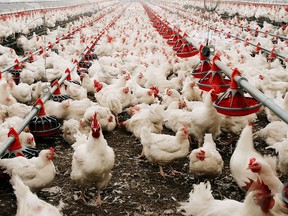The death of a Louisiana resident and a severe infection involving a B.C. teen has experts worried about the emerging threat to humans

The bird flu virus that brought a Canadian teen to the “brink of death” may have mutated while inside her body to become more efficient at spreading among humans. The case, and the death of a Louisiana resident over the age of 65 who was hospitalized with a severe H5N1 avian flu infection in December, are stark reminders “that this is not a mild virus,” said Matthew Miller, Canada Research Chair in viral pandemics at McMaster University in Hamilton. The Louisiana fatality marks the first U.S. death from highly pathogenic avian influenza. The B.C. girl’s infection is Canada’s first domestically acquired case of H5N1.
Recommended Videos
The patient in Louisiana was exposed to an infected backyard flock. So far, it’s not clear how the B.C. teen was infected. But why are people drawing connections to the cases?
What’s worrying is that the cases of human spillovers up to this point have been disproportionately relatively mild. They’re atypical of what we’ve experienced historically since the early 2000s with H5N1, in that most individuals have had conjunctivitis (pink eye), limited respiratory involvement and have recovered on their own.
Now we’ve seen two very severe cases, one that resulted in a fatality in an older individual who had underlying medical conditions and, at the other extreme in B.C, a very severe case that put a young person with not really any remarkable underlying medical conditions right at the brink of death.
The people who have been infected have disproportionately been from a very narrow demographic — mostly farm workers in the U.S. who are disproportionately healthy adults. And so we’re not really seeing the potential range of severe disease that the virus is capable of causing across the population.
Scientists have reported that genomic sequencing of a specimen taken from the B.C. teen showed mutations that might increase the ability of the virus to latch onto receptors in human airways. Could it have mutated while inside her body?
When people analyzed this case they saw one mutation in the protein that helps the virus replicate that’s been observed in virus isolated from other mammalian species. But there were two other mutations that have not been observed before in the protein that the virus uses to get into cells.
It’s similar to what we observed during COVID-19: A lot of the variants of concern that emerged were thought to emerge in people who were infected for long periods of time and who maybe couldn’t clear the virus normally because their immune system wasn’t functioning optimally. The longer a person is infected, the more chances the virus has to accumulate mutations within that person that makes it better at infecting humans.
Every time a person is infected with H5N1 we’re giving the virus the optimal chance to learn how to infect humans efficiently and to transmit between humans efficiently, which is one major barrier to a pandemic right now.
That’s why it’s important that no infection be viewed as acceptable.
We’re in the midst of respiratory viral season now, with RSV, COVID and influenza. What’s the worry over co-infection with H5N1?
That an H5N1 virus might recombine with a seasonal flu virus. Flu viruses can rapidly pick up entirely new genes. That’s the fast-forward pathway to a pandemic. H5N1 could pick up a gene from a human flu, which is already very transmissible, and then gain the ability to transmit effectively almost overnight.
What people are really worried about are swine or pigs. Because pigs are quite readily infected with both avian influenza viruses (they have a lot of exposure to wild birds) and human influenza viruses (exposure to infected humans tending to them). The most recent flu pandemic was the 2009 so-called swine flu pandemic. That pandemic emerged when three different viruses — a human virus, an avian virus and a swine virus — all mixed together.
Pigs are a well-known high-risk host for the emergence of pandemics because of their unique ability to be infected very efficiently by both avian and human influenzas.
You and your colleagues are looking at immune responses to H5N1 across the age spectrum. Who might be at the highest risk?
What are you watching for?
What everybody is most concerned about right now is any evidence of onward transmission from humans, which we haven’t seen so far, thank goodness.
But we’re still seeing a very intense outbreak in dairy cattle in California. There are still cases in dairy cattle in Texas and obviously there’s tonnes out there in wild birds and in poultry settings in North America and around the world. That is continuing to put people at high risk of occupational exposure.
The two next steps that present the most worry: any evidence of human-to-human transmission and any evidence of expansion of this virus into swine populations.
The situation right now is low risk for the average person. The problem is that in humans, that risk can massively change overnight. It’s not necessarily a slow ramp-up. It could go from a low-risk situation to a very high-risk situation with very little warning.
National Post
Our website is the place for the latest breaking news, exclusive scoops, longreads and provocative commentary. Please bookmark nationalpost.com and sign up for our daily newsletter, Posted, here.